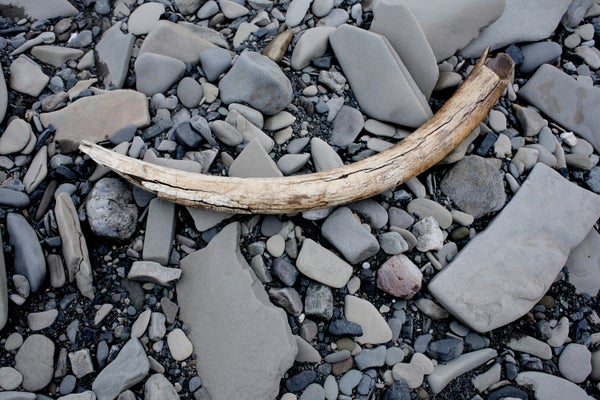Mammoths are among the best-known inhabitants of the last ice age, but their travels across the tundra have long remained a mystery. Now experts have used the chemical composition of a 17,100-year-old mammoth tusk from Alaska to map out where the animal wandered during its lifetime. They found it put in almost enough miles to loop around the world twice.
Woolly mammoths roamed North America, Europe and northern Asia during the last ice age. Most died out about 10,000 years ago, with a few populations surviving until around 2000 B.C. on a small island in the Arctic Ocean. Millions of long, hefty tusks from the now extinct giants are buried in the Arctic and Siberian earth today, still so intact that they are sought after as sources of commercial ivory. But their value is not just ornamental. “Tusks are like timelines,” says Matthew Wooller, a paleoecologist at the University of Alaska Fairbanks and first author of the new paper.
A silvery, alkaline earth metal called strontium comes in different versions, or isotopes, each with a different atomic mass. The proportions of these isotopes vary in soils around the world. When mammals eat plants growing in these soils, small amounts of strontium are incorporated into their bones and teeth—and, in the case of mammoths, their tusks, which are modified incisors.
On supporting science journalism
If you're enjoying this article, consider supporting our award-winning journalism by subscribing. By purchasing a subscription you are helping to ensure the future of impactful stories about the discoveries and ideas shaping our world today.
Tusks “are excellent records of Earth’s history because they grow in layers,” says Kathlyn Smith, a paleontologist at Georgia Southern University, who was not involved with the new study. By bisecting a tusk and examining the many chemical layers within, Wooller and his collaborators began a first-of-its-kind analysis: they mapped the travels of the tusk’s owner 17,000 years after it died.
Wooller and his team delicately sliced the tusk in two down the middle—a risky task that required careful planning and caused Wooller what he calls “a year of nightmares” about shattering it and rendering it useless. The researchers then measured the ratios of strontium isotopes along the five-and-a-half-foot-long tusk and compared them to create an itinerary of where the mammoth wandered.
The tusk came from a male mammoth who lived to be about 28 years old during the last ice age in what is now Alaska. Throughout its lifetime, it walked nearly 50,000 miles, the team reports in Science, challenging an impression among some that mammoths were more sedentary beasts. “All of us went into the project with a preconceived idea of what mammoth behavior is,” Wooller says. But the researchers ended up with “surprise after surprise after surprise.”
When the mammoth was young, it likely moved around inland Alaska as part of a herd, similar to the behavior of modern juvenile elephants. At around age 16, at the onset of sexual maturity, it struck out on its own and traveled for long distances on both sides of the Arctic Circle. In the last year and a half of its life, it mostly stayed within a small region in the northern part of present-day Alaska. Telltale isotopic signatures indicate that it likely starved to death near the foothills of the Brooks Range.
“One thing that was really exciting was seeing how the range of this mammoth changed with different stages in its life,” Smith says. The fact that its range expanded at age 16 “is really cool and is something we see in elephants.” Woolly mammoths reached approximately the size of the African elephant, the largest living land mammal today, and the two related species share other similar traits. Like their modern-day analogues, mammoths lived in matriarchal packs, and Smith wonders how lifetime mobility might have differed between a male, such as the one in Wooller’s study, and a female. Wooller and his team plan to apply the same technique to many more specimens in the coming years. “We have hundreds of mammoth tusks,” he says. “We’d love to do more tusks.”
This article originally appeared in Spektrum der Wissenschaft and was reproduced with permission.
